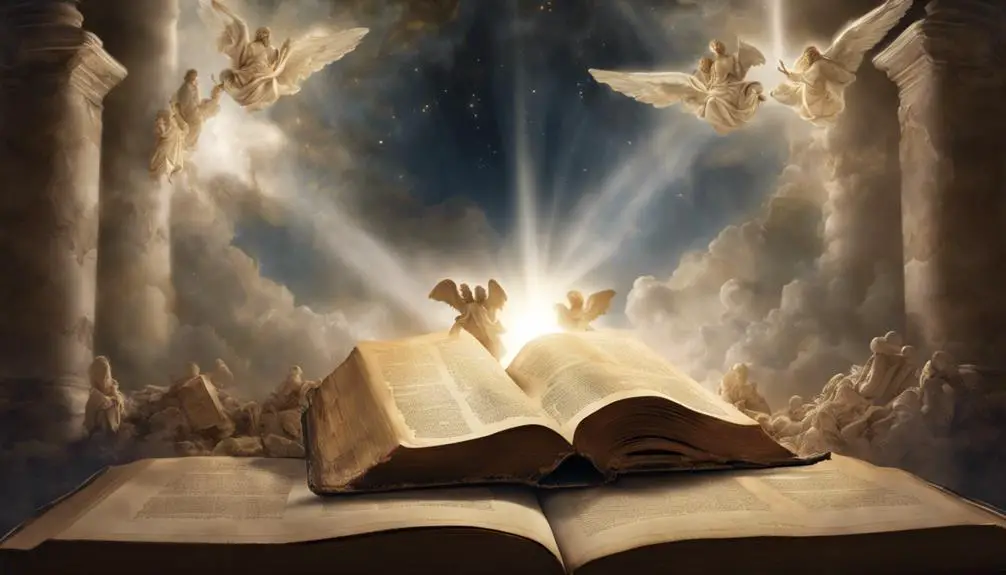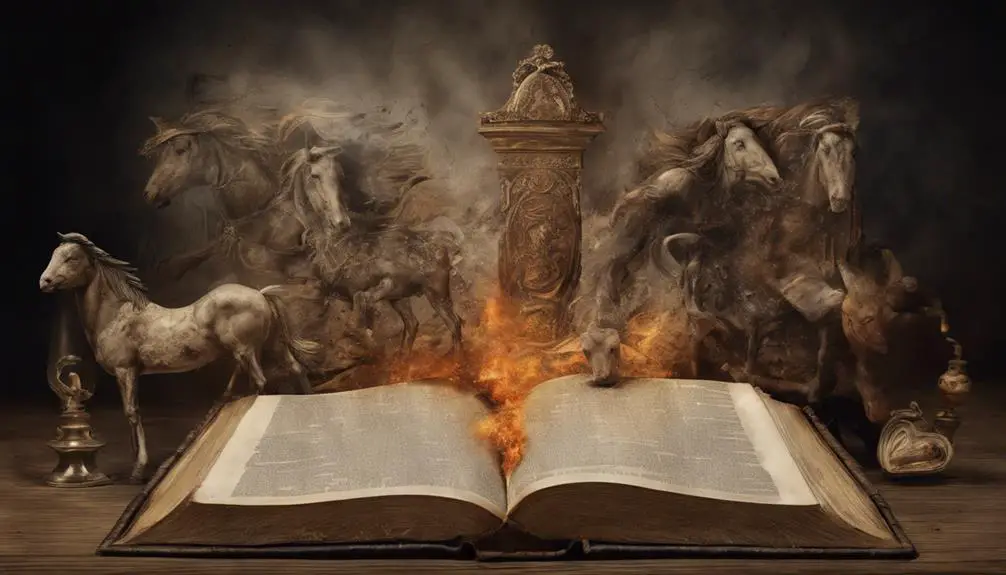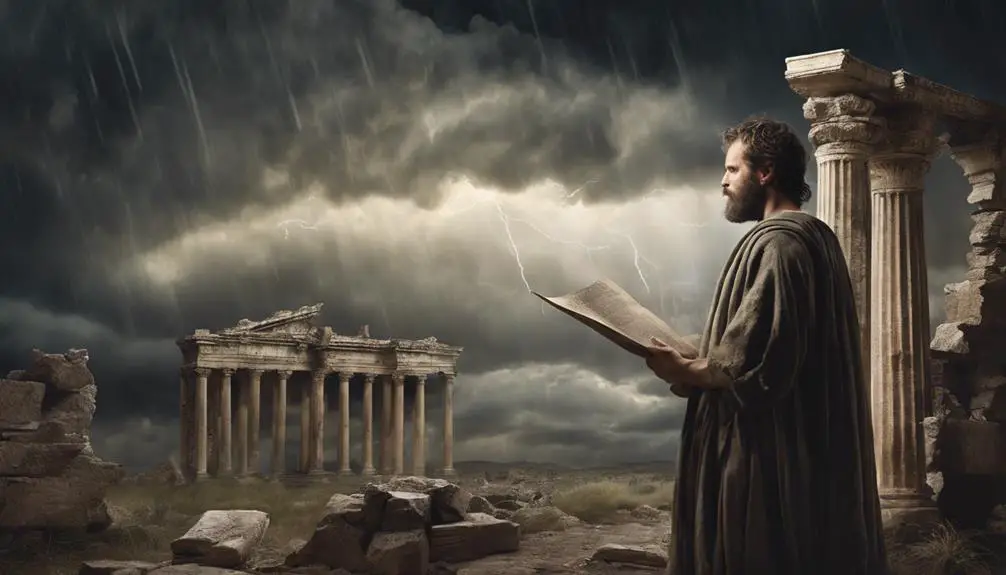Learn about biblical passages discussing the end of the world, unveiling intriguing interpretations that will captivate and surprise you.

What Bible Verse Talks About the End of the World
Have you ever pondered the inevitable, the end of the world as the Bible portrays it? It's a topic that's captured the imagination and curiosity of many.
You might be familiar with the Book of Revelation, but there are numerous passages scattered throughout the scripture that hint at the apocalypse. Matthew, Thessalonians, and even Daniel have something to say about it.
So, let's dive into this deep and complex subject, unearthing the mysteries and interpretations that have been debated for centuries. Who knows, you might discover answers that will surprise you.
Key Takeaways
- Revelation prophecies use symbolic visions to depict the end of the world, including beasts, seals, and trumpets.
- Paul's letters to the Thessalonians stress vigilance and preparedness for the sudden return of Christ.
- Matthew's eschatological discourse warns of tribulations, deceptions, and emphasizes readiness for Jesus' return and final judgment.
- Daniel's vision, featuring beasts and horns, symbolizes kingdoms and kings, providing insight into end times prophecy.
Understanding Biblical Apocalyptic Literature

Delving into the Bible's apocalyptic literature, you'll find it's a genre steeped in symbolism and prophetic visions, offering a profound perspective on the end times. This literature isn't merely about foretelling a catastrophic finale, rather, it's about communicating God's sovereignty and ultimate triumph over evil.
The term 'apocalyptic' is derived from the Greek word 'apokalypsis' meaning 'unveiling' or 'revelation'. This doesn't merely refer to the revelation of future events, but to the unveiling of divine realities, truths, and purposes. Apocalyptic literature is thus a means of divine communication, using vivid imagery and symbolism to represent complex spiritual truths.
In this genre, cosmic battles, angelic and demonic forces, numbers, colors, and animals often symbolize deeper realities. For instance, beasts often represent empires or kings, while colors like white symbolize purity and black symbolize evil.
Moreover, it's essential to understand that apocalyptic literature is highly contextual, written during times of intense persecution and suffering. It's intended to encourage believers, reminding them that despite current adversities, God's victory is assured.
In essence, Biblical apocalyptic literature is a rich, symbolic tapestry that communicates complex spiritual realities, providing a hopeful and reassuring message about God's ultimate triumph. This understanding is key to interpreting verses about the end of the world.
The Book of Revelation's Prophecies

Unveiling the mysteries of the Book of Revelation's prophecies, you'll encounter a series of vivid visions that portray the end of the world, each one rich with symbolic details and profound spiritual insights. You'll find descriptions of catastrophic events, such as the opening of seven seals by the Lamb, heralding various calamities. The blowing of seven trumpets by angels leads to more cataclysms, including the fall of a blazing star named Wormwood that taints a third of the world's fresh water, and the release of destructive locusts from the abyss.
The prophecy climaxes with the appearance of two beasts, symbolizing false prophets and oppressive political powers, followed by the Armageddon – the final battle between good and evil. It's essential to remember these visions aren't to be taken literally; they're metaphors representing spiritual truths.
You'll note a theme of divine judgment and retribution, intertwined with a promise of new creation, encapsulated in the vision of the New Jerusalem. As you delve into Revelation's prophecies, you'll find they don't merely predict doom, but ultimately convey a message of hope and renewal for those who remain faithful amid tribulations.
The Thessalonians and the End Times

Moving from the apocalyptic visions of Revelation, let's turn our attention to the Thessalonians' perspective on the end times. The Thessalonians' views, primarily encapsulated in the two epistles to the Thessalonians written by Paul, present a somewhat different understanding of eschatology.
The verses here shift focus from symbolic imagery to direct instruction and encouragement for believers. You'll see that Paul emphasizes the suddenness of Christ's return and the need for constant vigilance and preparedness. He also assures the Thessalonians that God has not destined them for wrath, but for salvation through Jesus Christ (1 Thessalonians 5:9).
Let's break down two key verses in a table to clearly understand their implications:
Verse |
Implication |
|---|---|
1 Thessalonians 4:16-17 |
The Lord's return will be sudden and unmistakable, with a loud command, voice of archangel, and trumpet call of God. Believers, both dead and alive, will be caught up together to meet the Lord. |
1 Thessalonians 5:2-3 |
The day of the Lord will come like a thief in the night. While people are saying "peace and safety", destruction will come suddenly. |
This detailed analysis of Thessalonian eschatology highlights the thematic emphasis on suddenness, vigilance, and salvation.
Matthew's Eschatological Discourse

Next, let's unpack Matthew's eschatological discourse, a crucial part of the Synoptic Gospels, where Jesus himself provides insights about the end times. This discourse, also known as the Olivet Discourse, is found in Matthew 24-25, and is a comprehensive teaching on the future events leading to the end of the world.
In this discourse, you'll find Jesus answering his disciples' questions about the signs of his second coming and the end of the age. He warns about deceptions, conflicts, and tribulations that will precede his return. He also provides the Parable of the Fig Tree as a metaphor to symbolize the recognition of these prophetic signs.
Moreover, Jesus emphasizes the importance of readiness and faithfulness through the Parables of the Ten Virgins and the Talents. He concludes with the depiction of the final judgment, where the 'Sheep and the Goats' are separated, and eternal life or eternal punishment is determined.
Thus, Matthew's eschatological discourse isn't just about catastrophic events, but also about spiritual preparedness, righteousness, and judgment. It's a complex, multifaceted prophecy that requires careful interpretation and understanding.
Daniel's Vision and Interpretation

Shifting our focus to the Book of Daniel, particularly Daniel's vision and its interpretation, we find another significant prophecy that sheds light on the end times. In Daniel 7, the prophet Daniel had a dream of four beasts, symbolizing four kingdoms. This vision, often interpreted as an allegory for the rise and fall of empires, also contains elements that many scholars link to the end of the world.
Vision Element |
Interpretation |
|---|---|
Four beasts |
Four kingdoms |
Iron teeth and bronze claws |
Powerful and destructive forces |
Ten horns on the fourth beast |
Ten kings |
An extra horn uprooting three |
An eleventh king, likely the Antichrist |
You see, the extra horn is described as having eyes like a man and a mouth that spoke boastfully. This aligns with the New Testament's depiction of the Antichrist, suggesting a connection between Daniel's vision and end times prophecy. It's important to interpret these symbols carefully, understanding their historical and prophetic contexts. Thus, Daniel's vision not only provides insight into history but also gives us a glimpse of the world's end as foretold in the Bible.
Conclusion
In conclusion, you've explored various biblical texts that address the end of the world. From Revelation's vivid imagery to Thessalonians' prophecies, Matthew's eschatological discourse, and Daniel's interpretive vision.
Each provides a unique perspective, underscoring the complexity of biblical apocalyptic literature. Remember, these texts are open to interpretation and reflect the concerns and hopes of their respective eras.
Your understanding will deepen with continued study and reflection.



Sign up